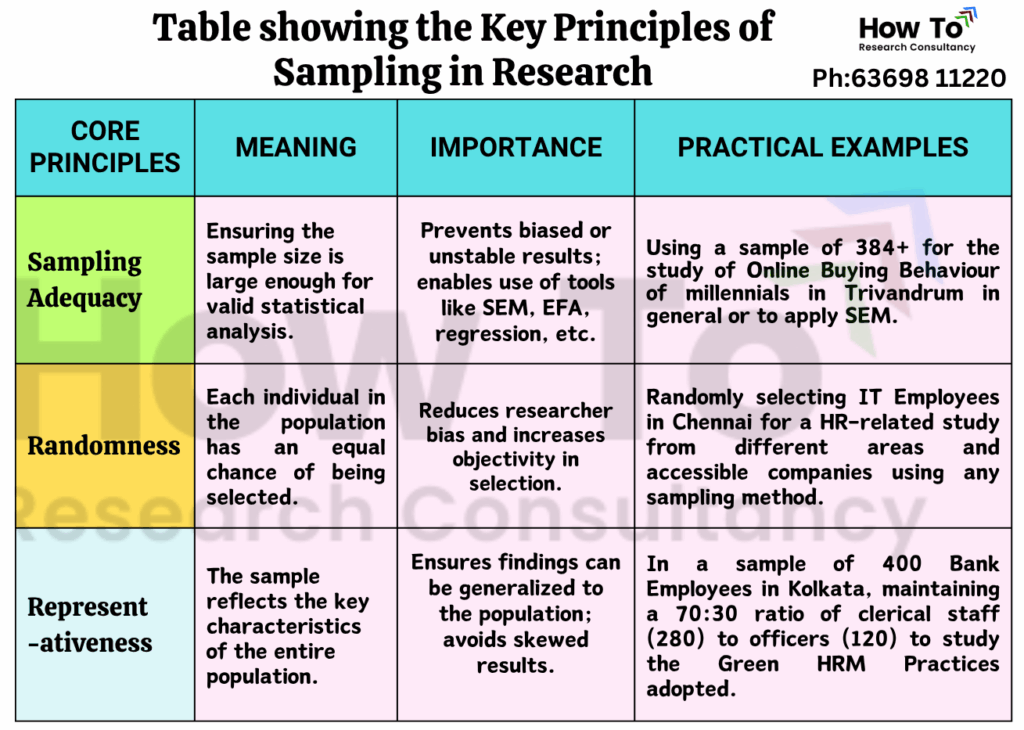Introduction
In the world of academic and applied research, especially when studying human behaviour, health outcomes, market trends, or technological adoption, the accuracy and credibility of findings often depend on sampling. However, an equally important yet sometimes overlooked concept is the sampling principles, which plays a pivotal role in ensuring the validity of a study.
This blog explores the concepts of population, sampling and their interrelated roles in the research process—supported with practical examples across different disciplines such as social sciences, healthcare, business, and education.
Population and the Need for Sampling
A population in research refers to the entire group of individuals, items, or events that possess certain characteristics relevant to a specific study. For instance:
- In public health, a population might be all diabetic patients in Tamil Nadu.
- In education, it could refer to all final-year engineering students in India.
- In business, the population may consist of all customers of a specific e-commerce platform.
While researchers may desire to study the whole population (a census), doing so is usually impractical, expensive, and time-consuming—especially for large populations. This is where sampling becomes essential.
What is Sampling?
Sampling is the process of selecting a subset (sample) from a population to represent the whole. A well-drawn sample helps generalize findings to the broader population while maintaining efficiency and cost-effectiveness.
Practical Example:
In a study to analyse smartphone usage behaviour among college students in India, surveying every student in the country is impossible. Instead, the researcher might sample 1,000 students across key metropolitan cities to infer general trends.
The Role of Sampling in Research
Sampling plays a critical role in determining the accuracy, reliability, and generalizability of a study. It also impacts:
- Statistical Power: Well-sized samples allow meaningful statistical testing.
- Bias Minimization: Careful sampling techniques reduce selection bias.
- Cost & Time: Reduces resource burden while still offering valuable insights.
Domain-Specific Examples
- Healthcare: Randomly selecting 500 patients with asthma from various hospitals to study the efficacy of a new inhaler.
- Marketing: Using quota sampling to include equal numbers of male and female consumers while evaluating a cosmetic product.
- HR: Selecting 400 employees of IT Sector in Chennai to study the Work Commitment.
- Tourism: Randomly selecting 500 tourists in Delhi to study their re-visit intention towards the tourist destination.
- Education: Selecting 100 schools through stratified sampling based on location (urban/rural) to study the impact of NEP 2020.
- Economics: Choosing 500 rural residents in select districts of Bihar to examine the Financial Inclusion and its outcomes on their lives.
Principles of Sampling
Sampling is a critical step in any research study, as it determines how well the findings can be generalized to the larger population. To ensure that the selected sample provides accurate, unbiased, and meaningful insights, certain guiding principles must be followed.
The three core principles of sampling—adequacy, randomness, and representativeness—help researchers select a sample that truly reflects the characteristics of the population and supports valid conclusions. These principles form the foundation of effective sampling design in both probability and non-probability approaches.
1. Adequacy
Definition
Adequacy refers to the appropriateness and sufficiency of the sample size required to draw reliable and valid conclusions from the study. A sample must be large enough to capture the essential characteristics of the population, enabling accurate statistical analysis and meaningful generalization. Tools such as Cochran’s formula and the Krejcie and Morgan Table are commonly used to determine an appropriate sample size based on the population size and desired confidence level. Moreover, the application of advanced statistical techniques like Exploratory Factor Analysis (EFA) and Structural Equation Modeling (SEM) necessitates an adequate sample to ensure the stability and robustness of the results.
Importance
- A small or inadequate sample may lead to biased, unstable, or unreliable results.
- Larger sample sizes reduce the margin of error and improve confidence in generalizing findings to the entire population.
- Adequate samples are essential when using advanced statistical tools like EFA (Exploratory Factor Analysis) and SEM (Structural Equation Modeling) to ensure model stability and valid results.
- Statistical tests such as regression, ANOVA, and t-tests require sufficient sample sizes to meet their assumptions and produce accurate p-values and standard errors.
- Inadequate samples increase the risk of Type II errors, where true relationships between variables may go undetected.
- Sample adequacy improves the power of the study, making it more likely to detect real effects or patterns.
- Software tools like SPSS, AMOS, and SmartPLS use checks such as the KMO (Kaiser-Meyer-Olkin) test to confirm if the sample is sufficient for factor analysis.
- Adequate sampling ensures that the results are replicable and acceptable for academic publication or policy decision-making.
Example
If you are studying the online buying behaviour of consumers in Trivandrum, Kerala, surveying only 100 people may lead to incomplete or unreliable results, as it may not reflect the diversity of consumer preferences. To ensure sampling adequacy, a sample size of at least 400 to 500 respondents is recommended, especially if the study involves multiple variables and advanced statistical tools like EFA or SEM. A larger sample size improves the accuracy, reduces the margin of error, and enhances the credibility and generalizability of the research findings.
2. Randomness
Definition
Randomness ensures that each individual in the population has an equal and independent chance of being selected in the sample. This avoids selection bias and enhances the objectivity of the research.
Importance
- Randomness ensures that every unit in the population has an equal and independent chance of being selected, reducing selection bias.
- It increases the objectivity of the research process by avoiding manual or preferential selection.
- Randomness in sampling enhances the validity and credibility of statistical results by ensuring neutrality in the sample.
- It supports the use of probability-based statistical tests, allowing for accurate estimation of confidence intervals and significance levels and also non-probability sampling methods.
- Randomness in samples enable researchers to generalize findings to the entire population with higher precision.
- In tools like SPSS or R, randomization techniques ensure fairness and accuracy in experimental or survey-based studies.
Example
When conducting a survey on IT employees in Bengaluru without a proper sampling frame, probability sampling becomes difficult. In such cases, data may be collected from easily accessible individuals like friends or colleagues in nearby IT firms—known as convenience sampling. While this method is quick and practical, it may not accurately represent the entire population. However, a degree of randomness can still be applied by randomly selecting participants from the accessible group, which helps reduce selection bias to some extent.
3. Representativeness
Definition
Representativeness means the sample must accurately reflect the diversity and characteristics of the total population. It should include all relevant sub-groups in the same proportion as they appear in the population.
Importance
- Representativeness ensures that the sample accurately reflects the key characteristics of the population, such as age, gender, income, occupation, etc.
- It allows researchers to draw valid conclusions and generalize results to the broader population.
- A representative sample minimizes coverage errors and underrepresentation of specific groups or sub-populations.
- It is crucial in studies involving diverse populations or stratified segments, such as customer behaviour, healthcare, education, and social research.
- Sampling techniques like stratified sampling or quota sampling or even Convenience Sampling help achieve representativeness by ensuring proportional inclusion of subgroups.
- Lack of representativeness may lead to biased results and misinterpretation of findings.
- Representativeness strengthens the external validity of the research, making the findings more applicable to real-world settings.
- It is especially important in policy research, market analysis, and social surveys, where decisions impact heterogeneous populations.
Example
If you are studying job satisfaction among bank employees in Kolkata, ensuring representativeness is crucial. For instance, if 70% of the workforce are clerical staff and 30% are officers or managers, your sample should reflect this ratio. So, in a sample of 400, including 280 clerical staff and 120 officers/managers ensures that insights are balanced and generalizable. Ignoring this proportion and overrepresenting easily accessible groups can lead to biased findings and limit the accuracy of your conclusions about the overall employee population.
Practical Example by taking the principles of Sampling
You are conducting a study on consumer behaviour towards Green Electronic Products in Chennai, focusing on working professionals.
Sampling Adequacy
Since you plan to use Structural Equation Modeling (SEM) for data analysis, you calculate the minimum required sample size using Cochran’s formula or refer to Krejcie and Morgan’s Table. Based on your study design and the expected population size, you determine that a minimum of 384 valid responses is required to ensure meaningful and statistically reliable results. You can take and finalise 400 to 500 samples.
Randomness (within Convenience Sampling)
Because there is no comprehensive sampling frame available for all consumers of green electronic products in Chennai, you choose convenience sampling. However, to introduce a degree of randomness, you approach participants in various public locations such as electronics stores, metro stations near IT parks, co-working hubs, and urban retail outlets or even you can choose samples, constituency-wise (South, North and Central Chennai). In each location/area, you follow any randomness approach to select the respondents—introducing systematic randomization within your convenience-based access.
Representativeness
To improve the representativeness of your sample, you intentionally collect responses from different parts/constituencies of the city (e.g., South Chennai, North Chennai and Central Chennai). This ensures that your sample includes a variety of income groups, age categories, education levels, and employment sectors. This geographic and demographic spread helps reflect the diverse population of Chennai and allows for broader generalization of your research findings.
This example shows how, even in the absence of a sampling frame, a researcher can still uphold key sampling principles by:
- Calculating the right sample size (adequacy),
- Applying systematic methods within convenience sampling (randomness),
- Ensuring inclusion of diverse respondent segments (representativeness).

Conclusion
Sampling plays a crucial role in research by enabling meaningful insights without surveying the entire population. To ensure quality and credibility, researchers must focus on key principles such as adequacy (ensuring a sufficient sample size), randomness (reducing selection bias), and representativeness (reflecting the population’s characteristics). Even in contexts where probability sampling is not feasible, careful planning within non-probability methods can uphold these principles. A well-structured sampling approach strengthens the foundation of any research study.
Need assistance in selecting the samples of your research, contact us!









Leave a Reply